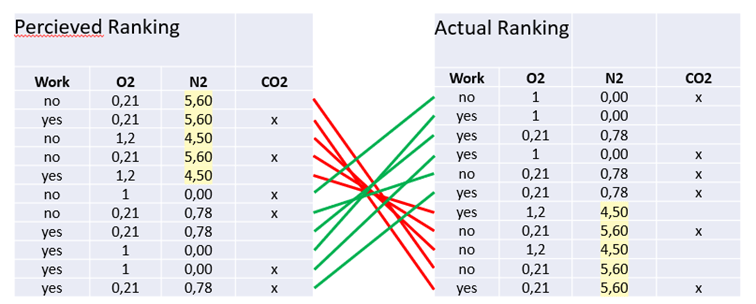Nitrogen Narcosis: Some Science
Can nitrogen narcosis be measured? (Relatively) current studies
There are many anecdotes about the nitrogen narcosis. But how much of this can be proven empirically? What is safe, and what is really just diver’s tales? What is known and what is simply not known?
In this chapter, we discuss the studies that have been carried out on the subject of nitrogen narcosis. On the next page, we show what arguments the results can provide in some current discussions.
CFFF – Tests
Critical Flicker Fusion Frequency
CFFF tests are used relatively frequently to determine the level of attention.
What is done there? An LED light flickers at a frequency that continues to increase. At some point, a person only perceives the flickering as constant light, so our ability to distinguish the individual periods of time in which the dot appears and disappears is limited. When exactly this happens can take place at different moments for different people – i.e. at different flicker frequencies. In reality, the dot is never really “continuous”, it just flickers faster and faster. The test is therefore carried out to determine the frequency up to which the test person can still recognize the flickering as such.
In most cases, the transition of perception from “flickering” to “continuous light” occurs at a frequency between 22 and 90 Hz, i.e. at 22-90 pulses per second.
The frequency at the moment at which the test person indicates the perception of the transition is noted: This is the Critical Flicker Fusion Frequency (CFFF), i.e. the frequency at which the flickering of the dot merges into a continuous light for the test subject.
On the one hand, this frequency depends on environmental factors (type of light stimulus, dark adaptation of the eye, an example of this is the situation in the cinema, where even relatively few images per second are perceived as a continuous film). On the other hand, however, it can be a measure of the general level of activation: The longer you perceive the flickering, the more alert and attentive you appear to be. Calibration is therefore carried out first to rule out environmental influences.
In order to measure how attention wanes for different things, it is first determined at what point a person sees the flickering as a continuous light in the “normal state”. The person is then exposed to different things – e.g. higher ambient pressure – and repeats the test. The two values are compared.
If constant light is already seen at a lower frequency, less brain activity is assumed than in the case of a fusion only at high frequencies.
Several studies have been carried out with CFFF tests. The frequency was evaluated here as a sign of attention. An attempt was therefore made to measure how attention increases or decreases during diving.
Shallow depth narcosis – Paper
Balestra, C et al. “Persistence of critical flicker fusion frequency impairment after a 33 mfw SCUBA dive: evidence of prolonged nitrogen narcosis?” European journal of applied physiology vol. 112,12 (2012)
First of all, there is a study from 2012 on whether narcosis persists on the surface after a 33m dive. We call it a “flat anesthesia study” – it is at the lower end of where anesthesia can be expected.
What did the researchers actually do? They had some fit men dive to 33m for 20 minutes, in warm, comfortable conditions, and had them do CFFF tests before, during, and after.
The frequency at which the test subjects perceive a flickering light as a continuous light during the dive was measured and used to determine how attentive a person is.
Result: At the beginning of the dive, alertness increases, but quickly decreases and remains slightly lower than before after the dive.
Breathing oxygen after the dive increases alertness quickly and significantly.
You can ask a few questions about the study. First of all, it is quite obvious that you are particularly attentive at the beginning of a reasonably deep dive, but then you relax and your attention wanes. The fact that people are less attentive under water than on land is probably immediately obvious to everyone: we know this, we have already discussed that the situation under water is unfamiliar to many. It also seems plausible that you are still a little tired afterwards.
But is what was measured here really a “nitrogen narcosis”? At such a moderate depth, can it not simply be what happens to people underwater at any depth? Some studies suggest that even at very shallow depths of just 5m, significant cognitive impairment can be detected. Of course, this can also be called narcosis – but whether it is really due to a narcotic effect of a gas cannot be proven.
Environmental conditions – Study
The same authors put the results to the test again a few years later, in 2016, under different conditions. They were in Tenerife under real diving conditions (Atlantic Ocean, water movement, but good visibility and relatively warm), in an indoor dive center with appropriate depth, and for comparison in a pressure chamber.
CFFF tests were also carried out here. In all three environments, the results were similar to those already shown in the previous study. There is no difference between environments with good visibility and tolerably warm temperatures.
However, no one has ever seriously claimed this difference. What many divers report, however, is that the nitrogen narcosis is stronger (or at least more noticeable!) at night or in cold, dark diving environments. Both have NOT been investigated, so we still don’t know anything for sure.
But: it seems immediately plausible that intoxication is perceived as frightening rather than euphoric when the surroundings are dark and cloudy….
Breathing gas comparison – Study
Rocco et al 2019 then went into really interesting depth: air, trimix and heliox in comparison (hereinafter: “breathing gas comparison study”).
Here, real dives were carried out to 50m, with a bottom time of 20 minutes. Here too, the participants took CFFF tests at the beginning, at the end and at 5m before the ascent. The people involved were all young, healthy men. In order not to distort the statistics, the few registered women were not allowed to take part. Here you can see a problem that unfortunately many diving studies have: the group of test subjects is usually very small and does not represent the diversity of real divers.
Result: At the beginning of the dive, alertness increases, then slowly decreases, but remains elevated. The lower the nitrogen content in the breathing gas, the better the results.
This is diametrically opposed to the previous results. While it was previously always assumed that attention was reduced and that this could be proven by CFFF tests, our divers are consistently more attentive at 50m with air than our less experienced test subjects at 30m.
Psychomotoric tests
MATB-II and others: grasping psychomotoric skills?
So far we have seen a few interesting studies, but they all have one problem in common: only the CFFF is measured, the interpretation as “attention” is just that, an interpretation. And whether this is really the only relevant sign of a nitrogen narcosis is open to debate.
What do we want to know when we are traveling really deep? We want to carry out our dive safely – this can be done relatively mechanically, it can be trained – and we want to react appropriately, flexibly and quickly in the event of problems. This becomes difficult in a state of intoxication – just as you can probably still turn the ignition key and put the car into gear after two pints of beer, but may not be able to brake quickly enough in traffic if an unexpected obstacle appears, you may not be able to get to grips with unexpected problems under water if you are intoxicated. And that can be dangerous….
Studies with more extensive tests are therefore extremely informative. Psychomotor skills come into view in different ways: What does depth do to memory? Is it still possible to react? How well can information be processed? And can you get problems under control?
Some studies use NASA’s MATB-II tests, which are designed for relatively simple devices. The skills tested here are those expected of air traffic controllers, for example, but as the tasks are relatively unspecific and simple, the results can provide good indications of general skills.
Psychomotor skills study
A study by Freiberger et al. is somewhat more complicated than the simple CFFF tests. 2016: Influence of N2, O2 and CO2 on psychomotor performance (hereinafter: “Psychomotor study”) This is freely available – if you would like to read it, you will find it linked above. It’s really worth it!
The conditions here are different to those for studies in water: in the Navy study, the test subjects sit with their heads out of the water in a pool in a pressure chamber, where they are exposed to the pressure that is to be measured. Here, pN2 up to 5.6 bar, pO2 up to 1.22 bar and an increased pCO2 at rest and in motion were used to adequately cover the spectrum of gas mixtures with regard to air/nitrox. They then carried out MATB-II tests in this position.
How they react, how quickly they react, how they process information, how well which part of their memory works – this was precisely measured here.
What the study revealed:
- Attention and reaction speed suffer from high pN2
- Memory also deteriorates under the influence of too much N2
- The reaction time for things to do with memory is also limited by O2 and CO2
- Planning and problem-solving skills are significantly limited at higher pN2 and pCO2
- Motor skills are not affected by the pN2
- Motor skills can be trained: divers and people who regularly play video games perform better
Perhaps the most interesting result of this study was not so much how the candidates actually performed under certain gas pressures, but how they themselves assessed the results.
Here is how the candidates themselves assessed their performance – and what the results actually looked like.
The result was quite similar to the self-perception of some drunk drivers: those who really couldn’t get their act together felt pretty good across the board. In contrast, the self-assessment of those who potentially had a clear head was consistently worse.
A high pN2 therefore very clearly leads to performance restrictions, but these are not always noticed by those affected. This is really important to know when someone tells you that they never have a nitrogen narcosis!

